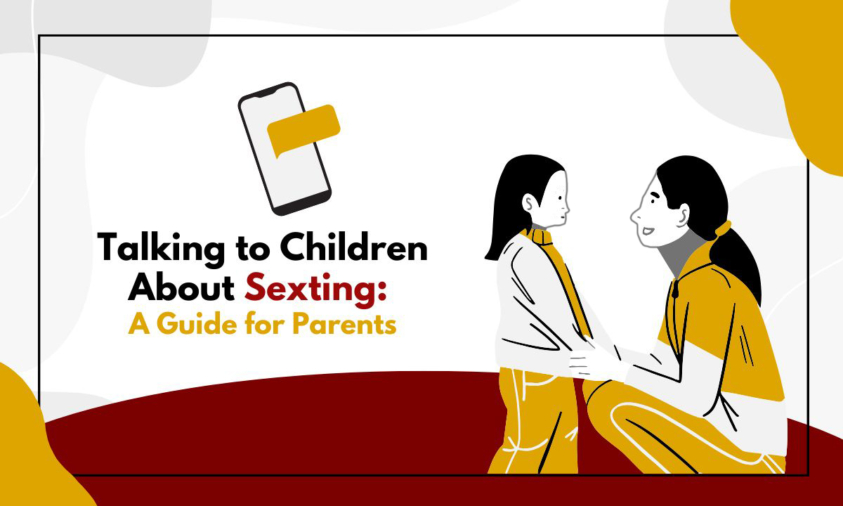Introduction
Sexting, the act of sharing sexually explicit messages or images electronically, has become increasingly prevalent among teenagers. For parents, discussing this sensitive topic with their children is crucial to ensure their safety, well-being, and understanding of responsible digital behaviour.
Here’s how parents can approach this conversation effectively:
Scenario 1: Confrontational Approach
Aditi (mom)
Suhani (daughter)
Aditi: I went through your phone and found explicit pictures of you, with and without your underwear, and you were sending it to your boyfriend, how could you do something so stupid?
Suhani: Mom, he has been my boyfriend for 3 years now, and i trust him completely. Why are you going through my phone and snooping?
Aditi: How can you say things like that? How do you know that you can trust him, and that is not even it, you should have never done that. You are acting like a slut.
Suhani: How can you say that mom? It’s not like I’m doing porn for random strangers on the internet.
Aditi: The fact that you can even speak about it like this, with no shame, is disgraceful. You must break up with him now and I will also take your phone away.
Suhani: You’re the worst mother ever. I hate you.
What went wrong?
Basically, everything. Approaching your child in a confrontational and judgmental manner will rarely lead to a productive conversation. In this scenario, Aditi’s accusations and harsh language made Suhani defensive and angry. By condemning rather than trying to understand her daughter’s behaviour, Aditi created more distance between them.
Instead, parents should aim to have calm, respectful, and empathetic conversations. Sexting happens for various reasons: curiosity, intimacy, pressure; and not all young people engage in it willingly. An open, non-judgmental approach encourages trust and honest dialogue.
Scenario 2: A Supportive and Open Approach
Suhani: Mom, my boyfriend had asked me to send him naked pictures, and I sent pictures, but I wore my underwear because I was uncomfortable sending it without them.
Aditi: I see, did he pressure you to send him these pictures when you didn’t want to? You know that saying “no” is your right and completely fine, right?
Suhani: Yes, I wanted to also send it to him, and he didn’t pressure me, I only sent it once I was comfortable.
Aditi: I need you to keep in mind that I trust your gut instincts. However, while I say that I also want to say that these are still intimate images, and it shouldn’t be taken lightly. And do you remember what I told you earlier?
Suhani: Yes of course! I have also previously told my boyfriend that it is illegal to forward revealing images/pictures, and I made sure he knows that it is not illegal for me to send it to him (this is true!)
Aditi: Good, and I am glad that you felt comfortable enough to tell me! Keep me informed like this in the future.
Why This Worked Well?
In this scenario, Aditi created an open and honest environment where Suhani felt safe sharing sensitive information. Instead of condemning her actions, Aditi focused on safety, consent, and trust. By keeping a neutral and supportive stance, Aditi ensured her daughter felt heard and respected while also reinforcing important lessons about boundaries and consequences.
How can Parents set Boundaries?
- Establish Clear Rules: Set guidelines for your child’s online behaviour and discuss what is appropriate to share.
- Emphasize Consent: Teach your child that saying “no” is their right and that they should never feel pressured into sharing intimate content.
- Encourage Self-Respect: Help your child set personal boundaries with themselves and their partner.
- Promote Digital Respect: Ensure your child understands the importance of respecting others in digital spaces, including not sharing others’ private images.
- Discuss Consequences: Make sure your child knows the legal and emotional implications of sending or receiving explicit content.
How can parents speak to their children about sexting?
- Create a Safe Space: Foster a comfortable environment for your child to discuss sensitive issues without fear of judgment.
- Talk Before Situations Arise: Address sexting early, so your child is prepared if the situation ever occurs.
- Educate on Consequences: Explain the potential legal issues, long-lasting digital footprints, and the importance of trust and privacy.
- Reinforce Open Communication: Encourage your child to come to you if they ever feel uncomfortable or pressured.
Conclusion
By adopting a supportive and educational approach, parents can guide their children through the complexities of sexting responsibly. Encouraging open communication, setting clear boundaries, and providing legal awareness are essential steps toward fostering a safe and respectful online environment for young individuals. In this way, you can help your child navigate the digital world safely and appropriately.
In case you are looking for customized child safety training, POCSO-related training, or POCSO advisory services, please feel free to reach out to us at +919004521614 or [email protected].
Authored by Tara Chanda, Content Writer Intern


 Cart is empty
Cart is empty 
